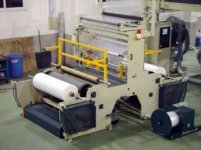Hi all,
I am rebuilding a circa 1970's twin surface winder for light gauge plastic film. The old motors were of the eddy current variety.
I have purchased load cells, AC motor and Weg CFW11 vector drive. I am going to use the drives inbuilt surface winder application as it looks after taper tension and has sub tension alarms etc. However I have one question with regards to the application.
(1.1kW 6 pole motors. 2 x Weg CFW11 vecter drives. 2 pairs of 2 x 25kg radial load cells. 150N desired web tension. 60m/min max line speed. Web width 1.5m. Gauge (calliper) 50 micron.)
I have traced through the program and it appears WEG's method is trim the master line speed reference with the output of the PID loop (PID out limits set to to -2 to 20%) (These are the default values). I have a concern that if I left the default values then if we had an upstream wrap around the winder would continue to wind at a speed of -2% of line speed. Obviously the web would snap.
Would I adjust the lower PID limit to -100%?
or, would I be better served using a window comparator looking at over tension to make coarse adjustments of the line speed reference?
The application inside the drive is written in ladder and is not OEM locked so if needed I have the power to program additional logic to alter the drives original application.
(By the way I am merely the plant sparky so no extreme terminology please.)
I am rebuilding a circa 1970's twin surface winder for light gauge plastic film. The old motors were of the eddy current variety.
I have purchased load cells, AC motor and Weg CFW11 vector drive. I am going to use the drives inbuilt surface winder application as it looks after taper tension and has sub tension alarms etc. However I have one question with regards to the application.
(1.1kW 6 pole motors. 2 x Weg CFW11 vecter drives. 2 pairs of 2 x 25kg radial load cells. 150N desired web tension. 60m/min max line speed. Web width 1.5m. Gauge (calliper) 50 micron.)
I have traced through the program and it appears WEG's method is trim the master line speed reference with the output of the PID loop (PID out limits set to to -2 to 20%) (These are the default values). I have a concern that if I left the default values then if we had an upstream wrap around the winder would continue to wind at a speed of -2% of line speed. Obviously the web would snap.
Would I adjust the lower PID limit to -100%?
or, would I be better served using a window comparator looking at over tension to make coarse adjustments of the line speed reference?
The application inside the drive is written in ladder and is not OEM locked so if needed I have the power to program additional logic to alter the drives original application.
(By the way I am merely the plant sparky so no extreme terminology please.)





